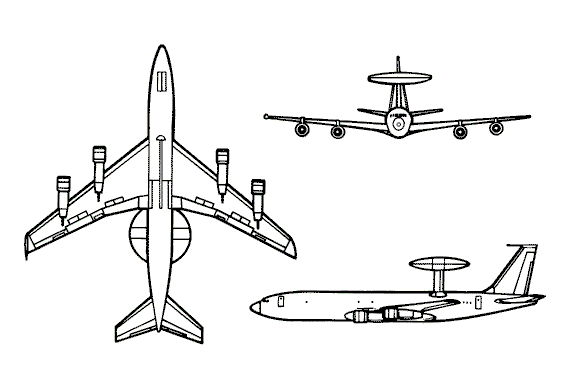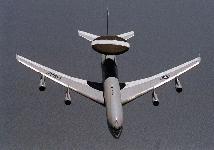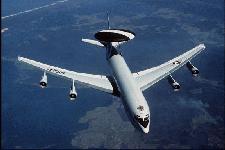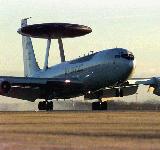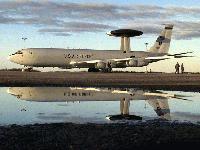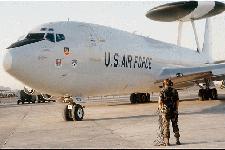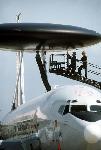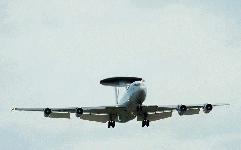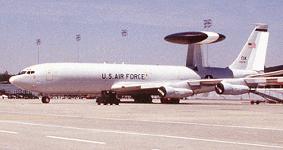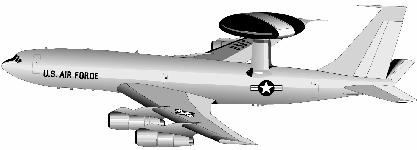




The E-3 Sentry is an airborne warning and control system (AWACS) aircraft that provides all-weather surveillance, command, control and communications needed by commanders of U.S. and NATO air defense forces. As proven in Desert Storm, it is the premier air battle command and control aircraft in the world today.
The E-3 Sentry is a modified Boeing 707/320 commercial airframe with a rotating radar dome. The dome is 30 feet (9.1 meters) in diameter, six feet (1.8 meters) thick, and is held 11 feet (3.3 meters) above the fuselage by two struts. It contains a radar subsystem that permits surveillance from the Earth's surface up into the stratosphere, over land or water. The radar has a range of more than 200 miles (320 kilometers) for low-flying targets and farther for aerospace vehicles flying at medium to high altitudes. The radar combined with an identification friend or foe subsystem can look down to detect, identify and track enemy and friendly low-flying aircraft by eliminating ground clutter returns that confuse other radar systems.
Other major subsystems in the E-3 are navigation, communications and computers (data processing). Consoles display computer-processed data in graphic and tabular format on video screens. Console operators perform surveillance, identification, weapons control, battle management and communications functions.
The radar and computer subsystems on the E-3 Sentry can gather and present broad and detailed battlefield information. Data is collected as events occur. This includes position and tracking information on enemy aircraft and ships, and location and status of friendly aircraft and naval vessels. The information can be sent to major command and control centers in rear areas or aboard ships. In time of crisis, this data can be forwarded to the National Command Authorities in the United States.
In support of air-to-ground operations, the Sentry can provide direct information needed for interdiction, reconnaissance, airlift and close-air support for friendly ground forces. It can also provide information for commanders of air operations to gain and maintain control of the air battle.
As an air defense system, E-3s can detect, identify and track airborne enemy forces far from the boundaries of the United States or NATO countries. It can direct fighter-interceptor aircraft to these enemy targets.
Experience has proven that the E-3 Sentry can respond quickly and effectively to a crisis and support worldwide military deployment operations. It is a jam-resistant system that has performed missions while experiencing heavy electronic countermeasures.
With its mobility as an airborne warning and control system, the Sentry has an excellent chance of surviving in war. Among other things, the flight path can quickly be changed according to mission and survival requirements. The E-3 can fly a mission profile for more than 8 hours without refueling. Its range and on-station time can be increased through inflight refueling.
The aircraft can be used as a surveillance asset in support of other government agencies during counter drug operations. U.S. Customs Service officers may fly aboard the E-3 Sentry on precoordinated missions to detect smuggling activities.
Engineering, test and evaluation began on the first E-3 Sentry in October 1975. In March 1977 the 552nd Airborne Warning and Control Wing (now 552nd Air Control Wing, Tinker Air Force Base, Okla.), received the first E-3s where they are still assigned. Pacific Air Forces has four E-3 Sentries assigned to the 961st Airborne Air Control Squadron (AACS), Kadena Air Base, Japan, and the 962nd AACS, Elmendorf AFB, Alaska. NATO has acquired 18 of the aircraft and support equipment. The first E-3 was delivered to NATO in January 1982. The United Kingdom has seven E-3s and France has four.
The AWACS Test System-3 (TS-3) test aircraft, a militarized 707, has been flying missions since the 1970s. TS-3 is maintained and operated in Seattle by Boeing for the US Air Force and has logged more than 1,000 flights and 6,800 flight hours testing AWACS enhancements such as radar improvements, new sensors, computers and displays.E-3 Sentry aircraft were among the first to deploy during Operation Desert Shield where they immediately established an around-the-clock radar screen to defend against Iraqi aggression. During Desert Storm, E-3s flew more than 400 missions and logged more than 5,000 hours of on-station time. They provided radar surveillance and control to more than 120,000 coalition sorties. In addition to providing senior leadership with time-critical information on the actions of enemy forces, E-3 controllers assisted in 38 of the 40 air-to-air kills recorded during the conflict. For the first time in the history of aerial warfare, an entire air war has been recorded. This was due to the data collection capability of the E-3 radar and computer subsystems.
Tinker AFB serves as the E-3 main operating base. Besides a full compliment of flightline support, Tinker AFB provides full back-shop support functions and the capability to access depot facilities. Kadena AB, Japan and Elmendorf AFB, Alaska are also permanent operating locations with assigned E-3s and flightline support, but limited back-shop capabilities. The E-3 is constantly deployed all over the world. Support at deployed locations ranges from full flightline support capabilities to bare base operations. However, all have limited back-shop support. A flightline maintenance support contingent is deployed with the aircraft. Back-shop support is normally not deployed.
In March 1996, the Air Force activated an AWACS Reserve Associate Program unit which will perform duties on active-duty aircraft. The unit is assigned to the 507th Operations Group at Tinker.
In December 1978, the NATO Defence Planning Committee decided to acquire a NATO owned Airborne Early Warning air defence capability to provide air surveillance and command and control for all NATO commands. In October 1980, the NATO Airborne Early Warning Force Command was formed with its Headquarters co-located with SHAPE. In addition to the HQ, the Force comprises two operational components, the E-3A Component at Geilenkirchen NATO Air Base, GE, and the E-3D Component at Royal Air Force Waddington, UK; three Forward Operating Bases located in Turkey, Greece and Italy and a Forward Operating Location in Norway. The E-3A Component operates 18 E-3A Airborne Early Warning and Control (AEW&C) aircraft and 3 Boeing 707 Trainer/Cargo aircraft. The E-3D Component operates 6 E-3D AEW&C aircraft. The E-3A Component is funded by 12 nations (Belgium, Canada, Denmark, Germany, Greece, Italy, Luxembourg, the Netherlands, Norway, Portugal, Turkey and the United States) and the NATO E-3A aircraft are manned by integrated, multinational crews from these countries, with the exception of Luxembourg. The E-3D Component represents the United Kingdom s contribution to the Force and its aircraft are manned by RAF personnel. The NAEWF is the largest commonly funded acquisition program undertaken by the Alliance and is the only NATO owned, multinational, operational force which is fully integrated into the command structure. Operational command of the Force is vested in, and collectively exercised by the MNCs through their executive agent, SACEUR, while the Force Commander exercises day-to-day Operational Control over the Force.
The AWACS Block 30/35 Modification is an in-progress production and installation program to add ESM, JTIDS, GPS Integrated Navigation, and additional computer processing power to the E-3. Major advantages include 200 times more accurate locations of targets passed via JTIDS (Link 16) and/or Link 11. GPS timing via 1553 bus synchronizes sensors, communications, and processors to common reference.
The AWACS Radar System Improvement Program (RSIP) is a hardware and software modification to the E-3 to improve radar set performance providing enhanced detection of targets, with an emphasis toward those with a low radar cross section (RCS). RSIP utilizes a Pulse Doppler Pulse Compression (PDPC) waveform, increases data sampling rates, increases range and velocity resolution, increases signal integration time, adds new signal processing algorithms to enhance detection sensitivity and unambiguous range determination, and improves radar set monitoring and control. Improved control and processing algorithms tailored to current threat data enhances system electronic counter-countermeasure (ECCM) capabilities. Major advantages include: Increased range against reduced RCS targets to include cruise missiles; Improved electronic counter-counter measures (ECCM) against current threats; Improved radar system reliability and maintainability (R&M); and Improved radar control and maintenance panel (RCMP) with embedded test equipment
The AWACS Combat ID /IFF program includes: (1) the IFF Top Priority program second part, Block 30/35 APX-103B, including scan-to-scan processing for code de-garble improvement, and obtaining aircraft attitude and altitude data via GINS 1553 Bus and (2) replacing the current IFF Transmitter with a new Solid State IFF Transmitter that corrects R,M,&A problems and provides Mode S compatibility. The SS IFF Transmitter is an Extend Sentry "#1 Must Do" item. Classified Combat ID may be POMed via this program but have zero required funding at this time. The IFF Top Priority must be totally in an installation phase by FY00. The SS IFF Transmitter will be acquired as a NATO and US AWACS coordinated (no MOA) Project. NATO will fund the R&D effort in FY00 but is taking a slightly different approach to IFF improvements so minor US design changes may be necessary. AWACS Communications Upgrades includes: Global Broadcast Service (GBS), digital communications system, and Intelligence Broadcast System (IBS). GBS is key to increased flow of ATO, weather and other information warfare data to be received by AWACS and key to moving mission crew to ground in future. The digital communication system is part of the NATO E-3 Mid Term and can result in deleting one or two Communication Technicians from mission crew composition. It is also key to mission recording capability for training and documentation - a top ACC/DO Extend Sentry objective. The IBS will require upgrade of MATT (currently being installed) to JTT for receipt of Broadcast Intelligence. Procurement will not be complete until 2009 at a total acquisition cost of $637.1M, and production and installation of different subprograms are on different schedules.The AWACS Computer & Display Modernization seeks to replace the E-3ís "steam driven computer" and is the highest ranked major project in the Extend Sentry priority list. Step 1 installation begins in the fall of 1998 with 1/3 of fleet complete at start of FY00 FYDP in an effort coordinated with NATO. The migration of the E-3 processing system to open system Defense Information Infrastructure Common Operating Environment (DII COE) compliance is as important to the AWACS mission as the RSIP sensor upgrade. The modernization of US AWACS mission computing capability is evolutionary. Itís goal is to inject crucial technological improvements in two steps. This approach is being used primarily due to funding constraints and the desire to get critical mission capabilities into the hands of the warfighter as soon as possible. The key components delivered to the user in Step 1 include a better target tracker algorithm, more detailed and useful maps, increased use of colors (allowing more and different symbols to be displayed), and an overall improved Human-Computer Interface (HCI) leading to better situational awareness. ATO processing, battle management decision aids, intel data overlays, weather overlays, and other critical software will be adapted from DII COE applications and delivered after the hardware and basic capability is in place. Step 2 of the AWACS mission computing upgrade provides the warfighter with a completely open DII COE compliant computing architecture enabling rapid, low cost delivery of plug and play capability. It involves the removal of the CC-2E computer and the Airborne Operational Computer Program (AOCP) mission software and full migration to DII COE compliance.
The proposed AWACS ESM Upgrades includes 4 sub-projects: (1) RF Front End Redesign to remove local oscillator leakage, increase producibility / maintainability, and remove current frequency management for cosite interference (Dem/Val flight in 4Q98/1Q99); (2) Specific Emitter ID provides ability for ESM ID to emitter serial number -key to Blue/Gray and increases correlation to tracks at higher rates than available from primary sensors; (3) Side Lobe Detection Enhancement increases the sensitivity beyond current capabilities such that emitters can be detected without the E-3 in the emitterís main beam; and (4) Multiple Platform Geolocation uses the ESM system to passively obtain very rapid and accurate geolocation of emitters. The future ELINT/ESM Joint needs picture is too cloudy to make a major investment decision on this above program at this point.
The AWACS Bistatic UAV Adjunct is a proposed $850M+ acquisition program with prototype in FY08 and completed in 2015. High Altitude Endurance (HAE) Dark Star/Global Hawk UAVs with bistatic receivers for the AWACS radar will expand area coverage of a single E-3 orbit and with the inherent significant signal to interference ratio enhancement provide increased coverage of low RCS targets while operating inside and outside an air defense threat environment. The inclusion of the Bistatic UAV adjunct to the E-3 would allow reduced E-3 operational tempo in some theaters and the ability to cover two major regional conflicts with fewer E-3s. By only carrying the receiver, IFF interrogator and a JTIDS/JCTN transmitter package, the UAV weight limitations can be met (combat ID systems might also be included if weight and size allows). The bistatic UAV would also be able to serve as an adjunct to the E-2, TPS-75 and other air/ground radars. Most important, the Bistatic UAV is a key part of the USAF transition from the E-3 to UAVs and Space for the AWACS mission, with the mission crew on the ground. The Bistatic UAV will be able to serve as the receiver using a satellite as the radar transmitter instead of the E-3. The bistatic UAV is a common link to a reduced E-3 fleet and use of Space for surveillance of large to LO/VLO air vehicles (missiles and aircraft) in the battlespace.
The proposed Mission Crew to Ground program migrates the battle management function off of AWACS to the ground to reduce manpower and cost, centralizes C2 in GTACS, provides room for additional E-3 sensor growth, and provides a transition step to move the majority of AWACS functions from the E-3 to UAVs and Space in the 2025 time frame. This program will allow more sensor growth in volume and weight on-board the E-3 for enhanced surveillance tasks without loss of time on station, and will centralize command and control at AOC/CRC nodes in the TACS using sensor data from AWACS and other sources such as UAVs. AWACS sensor data would be downlinked using LOS and/or SATCOM similar to the ground element of JSTARS today, but using the GBS (AWACS Comm Upgrades) with satellite cross-link capability. Only the Communications Technician, Airborne Radar Technician, and the flight crew stay aboard the E-3) and training savings for the USAF. The cost concept includes four ground stations (CONUS, CONUS backup and two theater deployable). Of a 33 aircraft fleet, only 27 E-3s are converted to a sensor platform configuration. Total acquisition cost is $1.52 Billion.Specifications | ||||||||||||||||
| Primary Function | Airborne surveillance, command, control and communications | |||||||||||||||
| Contractors | Prime: Boeing Aerospace Co. Radar: Northrop Grumman | |||||||||||||||
| Power Plant | Four Pratt and Whitney TF33-PW-100A turbofan engines | |||||||||||||||
| Thrust | 21,000 pounds each engine | |||||||||||||||
| Length | 145 feet, 6 inches (44 meters) | |||||||||||||||
| Wingspan | 130 feet, 10 inches (39.7 meters) | |||||||||||||||
| Height | 41 feet, 4 inches (12.5 meters) | |||||||||||||||
| Rotodome | 30 feet in diameter (9.1 meters), 6 feet thick (1.8 meters), mounted 11 feet (3.33 meters) above fuselage | |||||||||||||||
| Speed | Optimum cruise 360 mph (Mach 0.48) | |||||||||||||||
| Ceiling | Above 29,000 feet (8,788 meters) | |||||||||||||||
| Maximum Takeoff Weight | 347,000 pounds (156,150 kilograms) | |||||||||||||||
| Endurance | More than 8 hours (unrefueled) | |||||||||||||||
| Unit Cost | Approximately $270 million | |||||||||||||||
| Crew | Flight crew of four plus mission crew of 13-19 specialists (mission crew size varies according to mission) | |||||||||||||||
| Date Deployed | March 1977 | |||||||||||||||
|
Inventory As of Sept. 30, 2001 |
|
|||||||||||||||
| Losses | An E-3 crashed 22 Sep 1995 in Alaska, reducing the US fleet by one. | |||||||||||||||
| Production number | Serial number | Type | Operator | Delivered | Comments |
|---|---|---|---|---|---|
| 20518 | 71-01407 | E-3B | 552 ACW | ||
| 20519 | 71-01408 | E-3B | 552 ACW | ||
| 21046 | 73-01674 | E-3C | Boeing | ||
| 21047 | 75-00556 | E-3B | 552 ACW | ||
| 21185 | 73-01675 | E-3B | 552 ACW | ||
| 21207 | 75-00557 | E-3B | 552 ACW | ||
| 21208 | 75-00558 | E-3B | 552 ACW | ||
| 21209 | 75-00559 | E-3B | 552 ACW | ||
| 21250 | 75-00560 | E-3B | 552 ACW | ||
| 21434 | 76-01604 | E-3B | 552 ACW | ||
| 21435 | 76-01605 | E-3B | 552 ACW | ||
| 21436 | 76-01606 | E-3B | 552 ACW | ||
| 21437 | 76-01607 | E-3B | 552 ACW | ||
| 21551 | 77-00351 | E-3B | 552 ACW | ||
| 21552 | 77-00352 | E-3B | 552 ACW | ||
| 21553 | 77-00353 | E-3B | 552 ACW | ||
| 21554 | 77-00354 | E-3B | 552 ACW | crashed 22 Sep 95 | |
| 21555 | 77-00355 | E-3B | 552 ACW | ||
| 21556 | 77-00356 | E-3B | 552 ACW | ||
| 21752 | 78-00576 | E-3B | 552 ACW | ||
| 21753 | 78-00577 | E-3B | 552 ACW | ||
| 21754 | 78-00578 | E-3B | 552 ACW | ||
| 21755 | 79-00001 | E-3B | 552 ACW | ||
| 21756 | 79-00002 | E-3B | 552 ACW | ||
| 21757 | 79-00003 | E-3B | 552 ACW | ||
| 22829 | 80-00137 | E-3C | 552 ACW | ||
| 22830 | 80-00138 | E-3C | 552 ACW | ||
| 22831 | 80-00139 | E-3C | 552 ACW | ||
| 22832 | 81-00004 | E-3C | 552 ACW | ||
| 22833 | 81-00005 | E-3C | 552 ACW | ||
| 22834 | 82-00006 | E-3C | 552 ACW | ||
| 22835 | 82-00007 | E-3C | 552 ACW | ||
| 22836 | 83-00008 | E-3C | 552 ACW | ||
| 22837 | 83-00009 | E-3C | 552 ACW |
